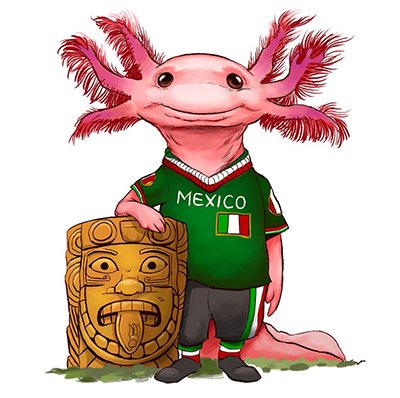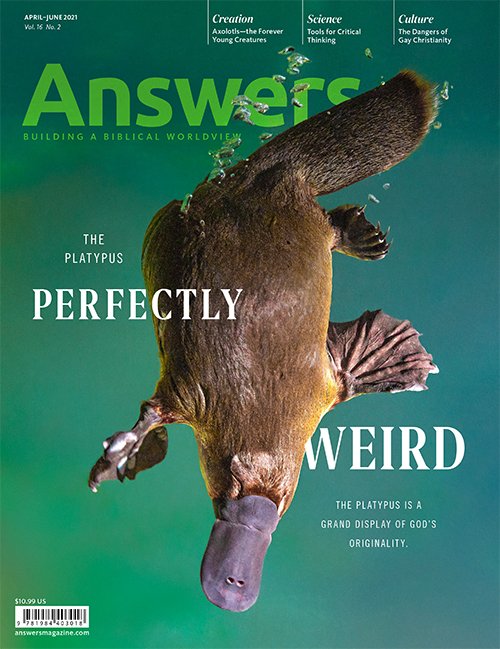Axolotl—Forever Young
Their ability to regenerate makes these salamanders the closest thing to the fountain of youth found in nature.
In addition to caring for over 200 animals at the Ark Encounter and Creation Museum zoos, I care for my own creatures at home. I have a dog and a ball python, but I recently decided to add another pet to my menagerie. I chose to adopt a truly unique creature—an axolotl. If you’re like most people, you’re probably wondering, “An axo-what?”
Axolotls (ax-oh-LOT-els) are aquatic salamanders that grow to about a foot long and are found only in the cool, dark waters of Lake Xochimilco (so-chee-MEEL-koh) and its surrounding canals near Mexico City. I’ve always been fascinated by these amphibians, and mine delights me every day with her goofy antics. With an array of unique, God-given features, axolotls make not only endearing exotic pets but also fascinating subjects of medical research.
Coat of Many Colors
Axolotls are normally mottled green and brown to camouflage underwater, but they also come in a stunning array of colors called morphs. My axolotl is black, but axolotls can also be copper, golden, lavender, gray, white, multicolored, pied, or albino. Many axolotls, mine included, have varying degrees of freckling on their bodies. Scientists have even created a morph called GFP (green fluorescent protein) that glows under blue or UV lighting.
Baby Face
Though people may have difficulty recalling its name, they rarely forget seeing an axolotl’s “smiling” face surrounded by fluffy gills. The reason for that lovable appearance is a characteristic known as neoteny (nee-OT-oh-nee), meaning axolotls retain some juvenile characteristics as adults. In a way, they never grow up.

Because axolotls retain some juvenile characteristics as adults, they appear youthful their whole life.
Most amphibians begin their lives as aquatic tadpoles and go through metamorphosis as they age, often growing legs and transforming into air-breathing, land-dwelling adults. However, axolotls appear to have gotten “stuck” halfway through the process. While they develop legs and lungs, can breathe air, and can sexually reproduce, they keep their feathery gills and tadpole tails and continue to live underwater.
Their neoteny stems from their lack of a thyroid-stimulating hormone. However, when given this missing hormone under human care, axolotls will complete their metamorphosis into fully terrestrial salamanders. In fact, axolotl neoteny helped scientists discover thyroid hormones.
Darling But Deadly
Despite being adorable, axolotls are far from innocent—they are formidable hunters. Before Adam and Eve sinned and creation was cursed (Genesis 3), all animals ate vegetation (Genesis 1:29–30). In today’s fallen world, axolotls consume worms, larvae, mollusks, crustaceans, and fish, using suction to vacuum prey into their mouths. My axolotl has terrible aim, but her mighty slurps are still powerful enough to catch her dinner.
Medical Marvels
Axolotls’ incredible regenerative abilities make them valuable research subjects in laboratories worldwide. They’re capable of regenerating not only limbs, but also jaws, spinal cords, tails, eyes, organs, and sections of their brains with no scarring. They can regenerate the same body part multiple times with no imperfections. Scientists have even successfully transplanted organs from one axolotl to another.
How do axolotls heal? When wounded, axolotls transform nearby cells into stem cells and recruit other stem cells in their body to come remedy whatever was injured. Studying axolotl regeneration has increased our knowledge of everything from embryonic development to organ transplants to amputations. Additionally, axolotls are over 1,000 times more resistant to cancer than mammals, so they’ve contributed to the research of curing cancer. In fact, an extract derived from axolotl egg cells successfully halts the spread of breast cancer. Their neoteny plus their healing abilities makes these animals the closest thing to the fountain of youth found in nature.
Tiger Hybrids
The majority of axolotls under human care are descended from just 34 specimens taken out of Lake Xochimilco during a French expedition in 1863 that sparked the worldwide interest in axolotls. Unfortunately, this has led to substantial inbreeding, so captive axolotls were crossed with tiger salamanders to broaden the gene pool. These hybridization efforts were successful because the two species belong to the same created kind (Genesis 1:24–25). Consequently, most axolotls under human care are actually part tiger salamander.
Salamanders in Danger
Sadly, wild axolotls are on the brink of extinction. A study in Lake Xochimilco in 1998 found 6,000 axolotls per square kilometer, but the most recent census in 2015 found just 35 axolotls per square kilometer.1 Scientists estimate there are fewer than 1,000 left in their natural habitat. Many of their original lakes have been drained, and populations are plummeting due to heavy pollution. Additionally, humans have introduced invasive fish into Lake Xochimilco that eat axolotls.
We can be thankful that biologists are working to inspire the Mexican people to save these amphibians before they go extinct. Researchers and locals have begun building axolotl shelters, growing water-filtering plants, and starting chemical-free floating crop fields in Lake Xochimilco as attempts to combat the pollution and invasive predators.
God calls us to be good stewards of his creation (Genesis 1:28), and we can obey that dominion mandate by working to save certain critically endangered species like axolotls. These creatures are incredible representations of God’s creativity and design, and contribute a great deal to advancing medical research. If these conservation efforts continue, I am hopeful that the amazing axolotl will live on to fascinate future researchers and pet owners like me.
Did You Know . . .

Art by DAVE MOTTRAM
Found exclusively in the lakes of Xochimilco near Mexico City, axolotls are sometimes called Mexican walking fish (although they’re not fish at all—they’re amphibians).
The name axolotl means “water dog” in the Nahuatl language of the Aztecs. It’s a nod to Xolotl, an Aztec god who, according to mythology, is said to have taken the form of a dog.
During courtship, male and female axolotls “waltz” with each other.

Art by DAVE MOTTRAM
Like all amphibians, axolotls’ skin is covered in a protective slime coat.
As amphibians, axolotls can breathe through their skin.
At 32 billion base pairs, the axolotl’s genome is 10 times the length of a human’s.
Answers Magazine
April–June 2021
Footnotes
- S.R. Voss, M. R. Woodcock, and L. Zambrano, Bioscience 65 (2015), 1134–1140.
Recommended Resources

Answers in Genesis is an apologetics ministry, dedicated to helping Christians defend their faith and proclaim the good news of Jesus Christ.
- Customer Service 800.778.3390
- © 2024 Answers in Genesis





